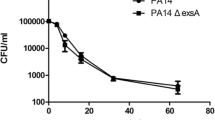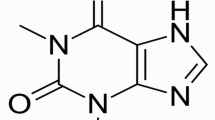Abstract
Pseudomonas aeruginosa is one of the most opportunistic bacterial pathogens in human communities. Being a potential antibacterial agent, antimicrobial peptide human β-defensin 3-carbohydrate-binding domain (hBD3-CBD) was evaluated in this study by in vitro bactericidal test, special gene expressions, hBD3-CBD effects on biofilm formation assays, swimming, twitching, and swarming activities of P. aeruginosa PA14, and hBD3-CBD effects on the antibiotic 50 % minimal inhibitory concentration (MIC50) and 90 % minimal inhibitory concentration (MIC90) against clinical P. aeruginosa isolates. The MIC against P. aeruginosa PA14 was 32 μg/ml; hBD3-CBD showed significant bactericidal activities when the concentration reached 8 μg/ml, and when the concentration reached 2 μg/ml, hBD3-CBD successfully repressed the biofilm productions in P. aeruginosa PA14. hBD3-CBD could inhibit the in vitro swimming, twitching, and swarming activities of P. aeruginosa PA14. When 5 μg/ml hBD3-CBD was combined with antibiotics, it decreased the MIC50 and MIC90 of tetracycline, rifampicin, and streptomycin against clinical P. aeruginosa isolates. As new antibacterial agents, hBD3-CBD and other AMPs might be used together with antibiotics to deal with infections in the future, especially the skin and soft tissue infections of drug-resistant P. aeruginosa.




Similar content being viewed by others
References
Bodey GP, Bolivar R, Fainstein V, Jadeja L (1983) Infections caused by Pseudomonas aeruginosa. Rev Infect Dis 5:279–313
Rossolini GM, Mantengoli E (2005) Treatment and control of severe infections caused by multiresistant Pseudomonas aeruginosa. Clin Microbiol Infect 11(Suppl 4):17–32
Obritsch MD, Fish DN, MacLaren R, Jung R (2005) Nosocomial infections due to multidrug-resistant Pseudomonas aeruginosa: epidemiology and treatment options. Pharmacotherapy 25:1353–1364
Fischetti VA (2001) Phage antibacterials make a comeback. Nat Biotechnol 19:734–735
Parisien A, Allain B, Zhang J, Mandeville R, Lan CQ (2008) Novel alternatives to antibiotics: bacteriophages, bacterial cell wall hydrolases, and antimicrobial peptides. J Appl Microbiol 104:1–13
Lee JK, Chang SW, Perinpanayagam H, Lim SM, Park YJ, Han SH, Baek SH, Zhu Q, Bae KS, Kum KY (2013) Antibacterial efficacy of a human beta-defensin-3 peptide on multispecies biofilms. J Endod 39:1625–1629
Li Q, Huang J, Guo H, Guo X, Zhu Y, Dong K (2012) Bactericidal activity against meticillin-resistant Staphylococcus aureus of a novel eukaryotic therapeutic recombinant antimicrobial peptide. Int J Antimicrob Agents 39:496–499
Samy RP, Thwin MM, Chow VT, Bow H, Gopalakrishnakone P (2011) Evaluation of antibacterial activity of proteins and peptides using a specific animal model for wound healing. Methods Mol Biol 716:245–265
Miki T, Holst O, Hardt WD (2012) The bactericidal activity of the C-type lectin RegIIIbeta against Gram-negative bacteria involves binding to lipid A. J Biol Chem 287:34844–34855
Jones C, Hachani A, Manoli E, Filloux A (2014) An rhs gene linked to the second type VI secretion cluster is a feature of the Pseudomonas aeruginosa strain PA14. J Bacteriol 196:800–810
Schaber JA, Carty NL, McDonald NA, Graham ED, Cheluvappa R, Griswold JA, Hamood AN (2004) Analysis of quorum sensing-deficient clinical isolates of Pseudomonas aeruginosa. J Med Microbiol 53:841–853
Darzins A (1993) The pilG gene product, required for Pseudomonas aeruginosa pilus production and twitching motility, is homologous to the enteric, single-domain response regulator CheY. J Bacteriol 175:5934–5944
Glessner A, Smith RS, Iglewski BH, Robinson JB (1999) Roles of Pseudomonas aeruginosa las and rhl quorum-sensing systems in control of twitching motility. J Bacteriol 181:1623–1629
Li Q, Zhou Y, Dong K, Guo X (2010) Potential therapeutic efficacy of a bactericidal-immunomodulatory fusion peptide against methicillin-resistant Staphylococcus aureus skin infection. Appl Microbiol Biotechnol 86:305–309
Zhu C, Tan H, Cheng T, Shen H, Shao J, Guo Y, Shi S, Zhang X (2013) Human beta-defensin 3 inhibits antibiotic-resistant Staphylococcus biofilm formation. J Surg Res 183:204–213
Bardoel BW, van Kessel KP, van Strijp JA, Milder FJ (2012) Inhibition of Pseudomonas aeruginosa virulence: characterization of the AprA-AprI interface and species selectivity. J Mol Biol 415:573–583
Medina G, Juarez K, Valderrama B, Soberon-Chavez G (2003) Mechanism of Pseudomonas aeruginosa RhlR transcriptional regulation of the rhlAB promoter. J Bacteriol 185:5976–5983
O’Loughlin CT, Miller LC, Siryaporn A, Drescher K, Semmelhack MF, Bassler BL (2013) A quorum-sensing inhibitor blocks Pseudomonas aeruginosa virulence and biofilm formation. Proc Natl Acad Sci USA 110:17981–17986
Li P, Poon YF, Li W, Zhu HY, Yeap SH, Cao Y, Qi X, Zhou C, Lamrani M, Beuerman RW, Kang ET, Mu Y, Li CM, Chang MW, Leong SS, Chan-Park MB (2011) A polycationic antimicrobial and biocompatible hydrogel with microbe membrane suctioning ability. Nat Mater 10:149–156
Ochsner UA, Vasil ML, Alsabbagh E, Parvatiyar K, Hassett DJ (2000) Role of the Pseudomonas aeruginosa oxyR-recG operon in oxidative stress defense and DNA repair: oxyR-dependent regulation of katB-ankB, ahpB, and ahpC-ahpF. J Bacteriol 182:4533–4544
Donlan RM (2011) Biofilm elimination on intravascular catheters: important considerations for the infectious disease practitioner. Clin Infect Dis 52:1038–1045
Hengzhuang W, Hoiby N, Ciofu O (2014) Pharmacokinetics and pharmacodynamics of antibiotics in biofilm infections of Pseudomonas aeruginosa in vitro and in vivo. Methods Mol Biol 1147:239–254
Kumar L, Chhibber S, Harjai K (2013) Zingerone inhibit biofilm formation and improve antibiofilm efficacy of ciprofloxacin against Pseudomonas aeruginosa PAO1. Fitoterapia 90:73–78
Dawgul M, Maciejewska M, Jaskiewicz M, Karafova A, Kamysz W (2014) Antimicrobial peptides as potential tool to fight bacterial biofilm. Acta Pol Pharm 71:39–47
Mulet X, Cabot G, Ocampo-Sosa AA, Dominguez MA, Zamorano L, Juan C, Tubau F, Rodriguez C, Moya B, Pena C, Martinez-Martinez L, Oliver A, Spanish Network for Research in Infectious D (2013) Biological markers of Pseudomonas aeruginosa epidemic high-risk clones. Antimicrob Agents Chemother 57:5527–5535
Kao CY, Sheu BS, Sheu SM, Yang HB, Chang WL, Cheng HC, Wu JJ (2012) Higher motility enhances bacterial density and inflammatory response in dyspeptic patients infected with Helicobacter pylori. Helicobacter 17:411–416
Perez-Osorio AC, Williamson KS, Franklin MJ (2010) Heterogeneous rpoS and rhlR mRNA levels and 16S rRNA/rDNA (rRNA gene) ratios within Pseudomonas aeruginosa biofilms, sampled by laser capture microdissection. J Bacteriol 192:2991–3000
Tremblay J, Deziel E (2010) Gene expression in Pseudomonas aeruginosa swarming motility. BMC Genom 11:587
Li Y, Qu HP, Liu JL, Wan HY (2014) Correlation between group behavior and quorum sensing in Pseudomonas aeruginosa isolated from patients with hospital-acquired pneumonia. J Thorac Dis 6:810–817
Steindler L, Bertani I, De Sordi L, Schwager S, Eberl L, Venturi V (2009) LasI/R and RhlI/R quorum sensing in a strain of Pseudomonas aeruginosa beneficial to plants. Appl Environ Microbiol 75:5131–5140
Schertzer JW, Brown SA, Whiteley M (2010) Oxygen levels rapidly modulate Pseudomonas aeruginosa social behaviours via substrate limitation of PqsH. Mol Microbiol 77:1527–1538
Guo Q, Kong W, Jin S, Chen L, Xu Y, Duan K (2014) PqsR-dependent and PqsR-independent regulation of motility and biofilm formation by PQS in Pseudomonas aeruginosa PAO1. J Basic Microbiol 54:633–643
Acknowledgments
This work was supported by National Natural Science Foundation of China (#81201334) and Shanghai Key Laboratory of Psychotic Disorders 13dz2260500.
Author information
Authors and Affiliations
Corresponding author
Additional information
Ping Lin and Yong Li have contributed equally to this work.
Rights and permissions
About this article
Cite this article
Lin, P., Li, Y., Dong, K. et al. The Antibacterial Effects of an Antimicrobial Peptide Human β-Defensin 3 Fused with Carbohydrate-Binding Domain on Pseudomonas aeruginosa PA14. Curr Microbiol 71, 170–176 (2015). https://doi.org/10.1007/s00284-015-0814-x
Received:
Accepted:
Published:
Issue Date:
DOI: https://doi.org/10.1007/s00284-015-0814-x




